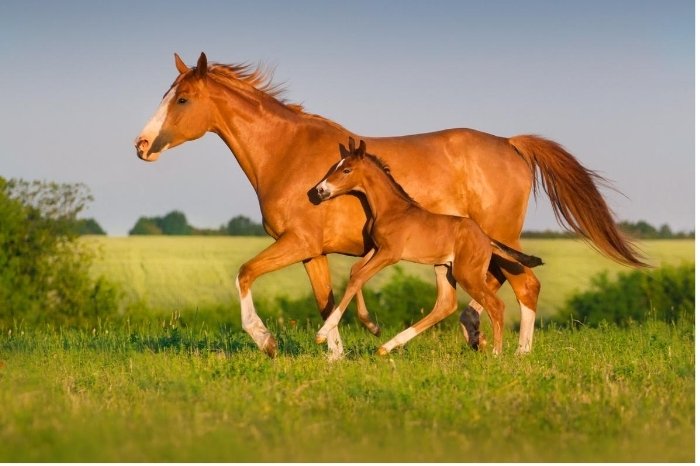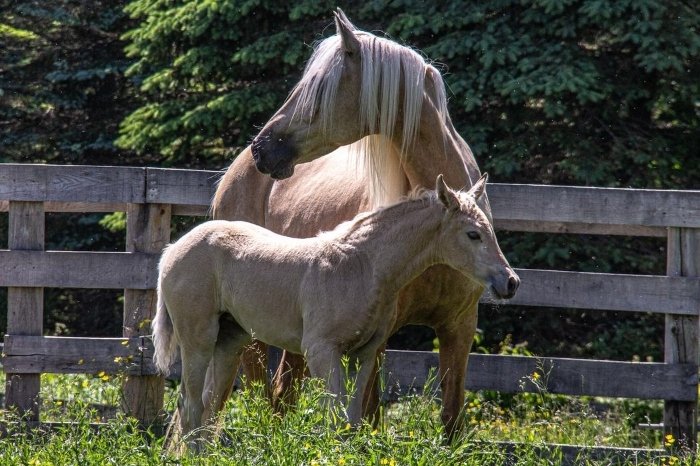Last Updated on December 29, 2021
One of the hardest parts about breeding is the anticipation of getting back in the saddle if your broodmare doubles as your riding mount. But how soon can you ride your mare after foaling? Veterinarians typically recommend a full 6-8 weeks post-partum before resuming work. However, the factors listed below may impact your specific situation.
How Soon Can You Ride a Mare After Foaling- Factors to Consider
Mare Health
Your mare’s post-baby health greatly depends on the actual birthing process, as well as her condition prior to and during pregnancy. Horses’ abdomens will actually decrease back to normal size within a few short weeks of giving birth. However, if there were foaling complications, your mare’s recovery and journey to “normal” may take a bit longer.
Edema normally resolves itself in a few weeks, but some stalled horses may have a longer period of excess fluid retention. More serious issues in foaling such as bleeding or internal organ damage will require veterinarian-advised healing and follow-up instructions. Minor birth-related issues such as bruising, swelling, or slight tears typically heal in a week or two.
Although horses tend to have excellent muscle memory, an owner will need to analyze their mare’s conditioning prior to revisiting work. If your mare was worked consistently and maintained good health, resuming work 6-8 weeks after a standard birth is typical.
Some owners have resumed light work as early as 4 weeks post-partum. However, working or riding any earlier may pose an increased risk for colic. Mares are more susceptible to colon-torsion-colic for a few weeks after birth. Ideally, a mare would be “fit and ready” to foal, making the transition back to work much smoother.
Location
Assuming your mare had a complication-free birth and is conditioned enough to resume work, it is important to analyze your riding facility conditions.
Your mare and foal will not be separated right away. This means you should ensure you are riding in a safe environment for the foal. If you have an extremely “independent” foal and a worrisome mom, it may be best to resume groundwork and wait until weaning for an enjoyable ride.
Weaning
Some owners opt out of riding entirely until weaning. Going back to work may also serve as a healthy distraction during the weaning process. For some mares, it may help dry up the remaining in milk supply!
Learn more about Foals-and-What-They-Eat
Conclusion
Because there are so many variables when resuming riding, you will have to make the final decision on when to ride again. Riding a mare with a new foal is not an uncommon practice. In fact, some horse shows still host a “Mare and Foal” class! For example, The Dublin Horse Show offers five different divisions under Mare and Foal, including Mare (with “Foal at Foot”)! Be sure to watch your mare for signs of distress, and monitor proper hydration due to increased water consumption during nursing. If you have any questions, seek direction from your veterinarian.
How soon did you return to riding your mare after she foaled? Let us know below, and be sure to share!
FAQs
How long does it take for a horse to recover from giving birth?
Undeniably, the process takes some time. A foal's first days of life are critical; during that time, he or she will be getting used to new surroundings and learning how to feed and grow. But as the weeks go by, most horses can begin working again. In fact, in most cases, the mare can begin work within six to eight weeks after foaling if everything went smooth and there were no complications while giving birth.
However, if the birth was complicated, it will take longer for the mare to recover. Some mares may develop edema in the legs and belly due to pregnancy-related circulatory issues. This is due to the high estrogen level during pregnancy. Some of these horses will also experience back pain or pelvic problems. This is because of the weight of the fetus and the increased blood volume.
How long do mares stay in foal?
Normal gestation length is 330 days or 11 months. The gestation period is the time from the first day of the last menstrual period (LMP) to the estimated date of parturition, which is the day when a mare usually gives birth to her foal. However, the mares can carry a fetus anywhere between 320 and 380 days without complications. If the mare delivers a foal early (i.e. at less than 320 days of gestation) the foal is considered premature. The premature foal requires special veterinary care if they are to survive. If foals are born before 305 days into gestation period normally don't survive. On the other hand, longer gestation periods (more than 380 day, up to one year) don't seem problematic.
How long can a pregnant mare be ridden?
It is safe to ride your mare during the first 7 months of her pregnancy. After that, you should avoid riding your mare for the danger of a miscarriage and infections.
The risk of miscarriage is the highest in the last 6 weeks of mare's gestation period if the mare is performing any kind of strenuous activity. Too much exercise can also contribute to an infection in mare's uterus or placenta, which may cause the foal to be born prematurely. Some viral, bacterial, and fungal infections can even cause a miscarriage. After miscarriage she will be more likely to miscarry again. It's important to understand that mare's pregnancy can be delicate and you need to take special care of your mare's health and well-being during that period.
Can you ride a mare after breeding?
After breeding mare should not be ridden for at least four weeks. This allows the embryo to start developing safely and gives the mare time to rest and recover as she is at the most uncertain time of her pregnancy in those 30 days. After first two weeks post breeding a vet can already confirm the pregnancy by ultrasound, although the embryo is still in a very sensitive phase at that time. It's only after one month that the mare can slowly start to exercise again, keeping in mind that the most important thing is for her to stay healthy throughout the pregnancy period and deliver a healthy foal.
Equestrian, Marine Corps vet, and Morgan horse enthusiast.

